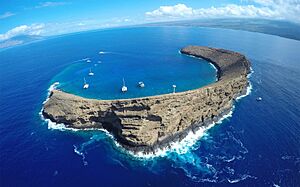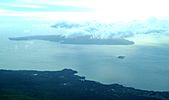Molokini facts for kids

Aerial photo of Molokini
|
|
| Lua error in Module:Location_map at line 420: attempt to index field 'wikibase' (a nil value). | |
| Geography | |
|---|---|
| Location | 20°38′00″N 156°29′46″W / 20.63333°N 156.49611°W |
| Area | 23 acres (9.3 ha) |
| Highest elevation | 161 ft (49.1 m) |
| Administration | |
|
Hawaiʻi, United States
|
|
| Demographics | |
| Population | 0 |
Molokini is a small, uninhabited island shaped like a crescent. It is actually a partially sunken volcanic crater. You can find it in the ʻAlalākeiki Channel, between the larger islands of Maui and Kahoʻolawe in Hawaiʻi.
Molokini is what's left of a very old volcano. This volcano was one of seven that formed the huge prehistoric island of Maui Nui a long, long time ago.
The islet is about 23 acres (9.3 ha) in size. It is about 0.4 miles (0.6 km) wide and its highest point is 161 feet (50 m) above the water. Molokini is located about 2.5 miles (4.0 km) west of Makena State Park. It is also south of Maʻalaea Bay. Because many seabirds live here, Molokini is a special Hawaiʻi State Seabird Sanctuary.
Contents
Fun Activities at Molokini
Molokini is a very popular spot for water activities like scuba diving, snuba, and snorkeling. Its unique crescent shape helps protect divers inside the crater from big waves and strong ocean currents. This makes it a safe and calm place to explore underwater.
You can also dive outside the crater along its steep outer wall, which drops about 300 feet (91.5 meters). In the mornings, when the ocean is usually calmer, smaller tour boats bring people to snorkel along this outer wall too.
Underwater Life and Visibility
The crater is home to a beautiful coral reef. The water here is incredibly clear, often allowing you to see as deep as 150 feet (46 m) (45 meters)! Molokini is special because it has about 250 different kinds of fish. Many of these fish are endemic, meaning they are found only in Hawaiʻi.
The best time to visit for clear water and calm conditions is early in the morning. Most of the allowed dive spots inside the crater are about 20 to 50 feet deep.
Protecting the Reef
Many boats visit Molokini, so the Hawaii State Division of Boating and Recreation has set up special mooring buoys. These buoys are like parking spots for boats. They help protect the coral reef from damage that could happen if boats dropped their anchors directly onto the coral. There are also "Day Use Mooring Rules" to ensure everyone helps protect this special place.
Molokini in Hawaiian Legend
Hawaiian legends tell a story about Molokini. It was once a beautiful woman who was in love with the same man as Pele, the fire goddess. Pele became very jealous. She cut her rival in half and turned her into stone.
According to the legend, the woman's head became Puʻu Olai. This is the cinder cone, a small volcanic hill, located near Makena Beach.
Molokini's Past
Scientists have studied Molokini's rocks and believe it erupted about 230,000 years ago. This was a very long time ago!
Early Hawaiians visited Molokini to fish. They used stone sinkers and lures, which archaeologists have found. They also likely collected seabirds, their eggs, and feathers from the islet.
World War II and Conservation
During World War II, the United States Navy used Molokini for target practice. Its shape looked a bit like a battleship from the air. This target practice caused damage to the islet's southwest rim.
In 1975 and 1984, the Navy found unexploded bombs inside the crater. When they blew up these bombs to get rid of them, large areas of coral were destroyed. This made many people upset. As a result, volunteer divers carefully searched for and removed any remaining unexploded bombs. A survey in 2006 confirmed that there were no more unexploded bombs on the islet.
From the 1950s to the 1970s, people harvested black coral from Molokini. To protect the area, Molokini islet, its crater, and the surrounding 77 acres (31 ha) of underwater land were declared a Marine Life Conservation District (MLCD) in 1977. This means it's a protected area where marine life can thrive.
Molokini's Amazing Ecosystem

Molokini crater is home to about 250 to 260 different kinds of marine animals. Some of the fish you might see often include the black triggerfish, yellow tang, Moorish idol, parrotfish, raccoon butterflyfish, and bluefin trevally. Because Molokini has been a protected area for a long time, the fish here are used to seeing divers nearby.
Sometimes, small whitetip reef sharks and moray eels are seen in the crater. You can also frequently spot Red pencil urchins.
Corals and Seabirds
The waters around Molokini have 38 different kinds of hard corals and about 100 types of algae. While there are many corals, they are not as dense as they used to be because of all the tourism.
The islet itself is a nesting place for at least two types of seabirds: Bulwer's petrels and wedge-tailed shearwaters. Great frigatebirds have also been seen on Molokini islet.
Rules for Visiting Molokini
Molokini islet is owned by the federal government and is a state seabird sanctuary. This means you are not allowed to land on the islet without special permission. You need to get permission from both the U.S. Coast Guard and the Hawaii Division of Forestry and Wildlife.
Molokini Shoal Marine Life Conservation District Rules
The rules for the Molokini Shoal MLCD (Marine Life Conservation District) are very important. They prohibit fishing, collecting or removing any plants or animals, and feeding the fish. Also, dropping anchors inside the MLCD is not allowed because it can damage the coral reef. Instead, tour boat operators use special fixed mooring points.
Snorkeling and scuba diving are the most popular activities at Molokini. Since the crater is made of rock, the water stays very clear, without much sand or dirt. The visibility at Molokini is usually more than 150 feet (45 meters). The inside of the crater is also generally protected from strong winds and waves.
The back wall of the island is considered one of the top 100 diving spots in the world. This "drift dive" allows you to float along steep drop-offs that go down 360 feet (110 meters) to the ocean floor, where you can see amazing reef and underwater life.
Molokini Crater Moorings
Commercial boats need special permits to moor (park) within the crater. A study in January 2020 showed that over 300,000 visitors came to Molokini crater each year. This large number of visitors is thought to have affected the marine life inside the crater.
In 2019, a new bill was proposed to help protect the marine wildlife. If it becomes law, it will reduce the number of moorings in the crater from over 20 to just 12. This will limit how many visitors can come to the crater at one time, helping to preserve its beautiful marine environment.
Gallery
-
Aerial view of Kahoʻolawe, Molokini and the Makena side of Maui
Images for kids
-
U.S. Coast & Geodetic Survey marker on Molokini
See also
 In Spanish: Isla Molokini para niños
In Spanish: Isla Molokini para niños







